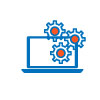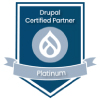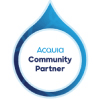Introduction: Drupal 7 Is Out. Now What?
Drupal 7 has powered websites for over a decade, but its era is over. As of January 5, 2025, the Drupal community has officially ended support for version 7. And while many businesses continue to operate on Drupal 7, the risks have moved from theoretical to operational.
This isn’t about a CMS anymore. It’s about risk exposure, revenue leakage, and the opportunity cost of standing still.
The State of Drupal 7 in 2025
Despite its end-of-life status, approximately 37% of all Drupal websites are still running on Drupal 7. For mid-size companies, that number is even higher due to slower infrastructure cycles, resource constraints, and the perceived complexity of migration.
But here’s the reality: if you're still on Drupal 7, you're on borrowed time and borrowed support. The longer you wait, the harder and more expensive it becomes to migrate. Not to mention the increased risk of running outdated infrastructure in a digital-first economy.
Why Drupal 7 Migration Can’t Wait
Drupal 7 migration isn’t just about software lifecycle; it’s about safeguarding the foundation of your digital presence. Staying on an unsupported CMS puts your business at risk in several critical areas:
1. Security
With no more security patches from the Drupal community, your site becomes a soft target for vulnerabilities. If you're handling user data or operating in regulated sectors like healthcare or finance, this is a ticking liability.
2. Compliance
Regulatory frameworks such as GDPR, HIPAA, and CCPA require up-to-date systems and regular maintenance. Running on Drupal 7 may put your organization out of compliance without you even knowing it.
3. Cost
Developer availability is shrinking. Maintaining outdated systems means patchwork development, growing technical debt, and rising costs. If you're calculating ROI, understand that delay adds direct and indirect expenses every month.
Industries We Serve
 Fintech
Fintech
 Healthcare
Healthcare
 Edtech
Edtech
 IT
IT
 Pharma
Pharma
Planning a Drupal 7 Migration: What You Need to Know
-
Custom Roadmaps
A mid-size retail business doesn’t need the same migration roadmap as a healthcare platform or education provider. Build a plan that’s aligned with your business model, your team’s capacity, and your long-term digital goals.
-
Stakeholder Buy-In
It involves marketing, compliance, customer support, and leadership. Engage your stakeholders early to shape the right migration blueprint, one that meets everyone’s goals.
-
Preservation of Functionality
Your business-critical workflows and features don’t need to disappear in migration. Proper mapping and testing allow for preserving essential functionality, content structures, and integrations.
-
Migration ROI
A successful Drupal 7 migration sets the stage for faster deployments, improved performance, and modern integrations. You’re not just rebuilding; you’re creating a platform that enables innovation.






Strategy in Action: CIO-Level Migration Thinking
At the leadership level, migration isn’t just tactical; it’s strategic. Here’s how CIOs and CTOs are reframing the conversation:
- As a risk mitigation strategy, ensuring the business remains compliant and secure.
- As a digital transformation milestone: aligning IT with business growth goals.
- As a cost-saving maneuver: reducing technical debt and improving operational efficiency.
The smartest leaders aren’t waiting for Drupal 7 to become a crisis. They’re using it as an inflection point to take control.
Success Stories
Enhancing Drupal Site Performance for LORD Corporation: A Mobile-Centric Performance Optimization
Project Summary:
The objective of this study is to showcase the process and results of optimizing the performance of Drupal website on both web and mobile platforms. By focusing on mobile devices, the aim was to significantly reduce page load times, improve user experience, and ensure optimal performance across different devices.
Feedback Summary:
Through targeted optimization strategies, LORD Corporation's Drupal website performance was significantly enhanced, with a specific focus on improving mobile performance. The optimizations undertaken resulted in faster page load times, improved user experience, and increased engagement. This case study underscores the importance of a comprehensive approach to performance optimization, ensuring that websites meet the expectations of users in an increasingly mobile-centric digital landscape.
At Valuebound, we don’t just write Drupal code, we design digital foundations that fuel enterprise growth. This project was proof that with the right architecture, governance, and collaboration model, even the most complex organizations can turn digital into a strategic advantage.
Frequently Asked Questions
You can maintain your current design and UI/UX while still upgrading the backend and infrastructure.
With the right partner and roadmap, the process becomes structured, predictable, and fully testable.
Every week post-EOL is a week you're operating at higher risk and higher cost.
It’s an entirely modern digital platform. Here's what you get post-migration: a modern admin experience with the Claro theme, mobile-first, accessible front-end via Olivero, improved caching, performance, and security architecture, and seamless integrations with headless frameworks and external APIs.
After migration, most organizations report 30–50% faster performance across key pages, reduced dev time for feature deployments, more agile marketing workflows, and better SEO and user engagement metrics. Most importantly, teams feel in control again- able to iterate and innovate, instead of patching legacy code or managing vendor dependencies.
If you’re unsure where to begin, here’s a proven path used by mid-size organizations:
Week 1: Audit your current Drupal 7 setup
Week 2: Map content types, modules, and functionality to Drupal 10 equivalents
Week 3: Create a staging environment for testing and validation
Week 4: Migrate, QA, and deploy
This rapid-start model isn’t for everyone, but for lean teams ready to move fast, it creates momentum.
Who we’ve partnership with





